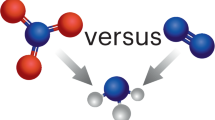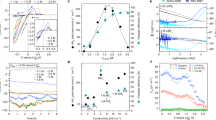Abstract
Ammonia is a widely produced chemical that is the basis of most fertilisers. However, it is currently derived from fossil fuels and there is an urgent need to develop sustainable approaches to its production. Ammonia is also being considered as a renewable energy carrier, allowing efficient storage and transportation of renewables. For these reasons, the electrochemical nitrogen reduction reaction (NRR) is currently being intensely investigated as the basis for future mass production of ammonia from renewables. This Perspective critiques current steps and miss-steps towards this important goal in terms of experimental methodology and catalyst selection, proposing a protocol for rigorous experimentation. We discuss the issue of catalyst selectivity and the approaches to promoting the NRR over H2 production. Finally, we translate these mechanistic discussions, and the key metrics being pursued in the field, into the bigger picture of ammonia production by other sustainable processes, discussing benchmarks by which NRR progress can be assessed.
This is a preview of subscription content, access via your institution
Access options
Access Nature and 54 other Nature Portfolio journals
Get Nature+, our best-value online-access subscription
$29.99 / 30 days
cancel any time
Subscribe to this journal
Receive 12 digital issues and online access to articles
$119.00 per year
only $9.92 per issue
Buy this article
- Purchase on Springer Link
- Instant access to full article PDF
Prices may be subject to local taxes which are calculated during checkout



Similar content being viewed by others
References
Wang, L. et al. Greening ammonia toward the solar ammonia refinery. Joule 2, 1055–1074 (2018).
Gilbert, N. Dirt poor. Nature 483, 525 (2012).
Smil, V. Enriching the Earth: Fritz Haber, Carl Bosch, and the Transformation of World Food Production. (MIT Press, Cambridge, 2004).
Erisman, J. W., Sutton, M. A., Galloway, J., Klimont, Z. & Winiwarter, W. How a century of ammonia synthesis changed the world. Nat. Geosci. 1, 636–639 (2008).
Service, R. F. Liquid sunshine. Science 361, 120–123 (2018).
Shipman, M. A. & Symes, M. D. Recent progress towards the electrosynthesis of ammonia from sustainable resources. Catal. Today 286, 57–68 (2017).
van der Ham, C. J. M., Koper, M. T. M. & Hetterscheid, D. G. H. Challenges in reduction of dinitrogen by proton and electron transfer. Chem. Soc. Rev. 43, 5183–5191 (2014).
Dolan, M. (ed.) Delivering clean hydrogen fuel from ammonia using metal membranes (AIChE, 2017).
Foster, S. L. et al. Catalysts for nitrogen reduction to ammonia. Nat. Catal. 1, 490–500 (2018).
Zhan, C.-G., Nichols, J. A. & Dixon, D. A. Ionization potential, electron affinity, electronegativity, hardness, and electron excitation energy: molecular properties from density functional theory orbital energies. J. Phys. Chem. A 107, 4184–4195 (2003).
Jia, H.-P. & Quadrelli, E. A. Mechanistic aspects of dinitrogen cleavage and hydrogenation to produce ammonia in catalysis and organometallic chemistry: relevance of metal hydride bonds and dihydrogen. Chem. Soc. Rev. 43, 547–564 (2014).
Licht, S. et al. Ammonia synthesis by N2 and steam electrolysis in molten hydroxide suspensions of nanoscale Fe2O3. Science 345, 637–640 (2014).
Zhou, F. et al. Electro-synthesis of ammonia from nitrogen at ambient temperature and pressure in ionic liquids. Energy Environ. Sci. 10, 2516–2520 (2017).
Low, M. J., Ramasubramanian, N. & Rao, V. S. Reactions of ammonia with porous glass surfaces. J. Phys. Chem. 71, 1726–1734 (1967).
Murray, C. A. & Greytak, T. J. Raman scattering from ammonia adsorbed on the amorphous silica surface. J. Chem. Phys. 71, 3355–3365 (1979).
Richardson, G., Davies, J. & Edwards, J. Micromolar ammonia analysis and atmospheric contamination. Fresenius J. Anal. Chem. 340, 392–394 (1991).
Warner, J. X. et al. Increased atmospheric ammonia over the world’s major agricultural areas detected from space. Geophys. Res. Lett. 44, 2875–2884 (2017).
Ianniello, A. et al. Occurrence of gas phase ammonia in the area of Beijing (China). Atmos. Chem. Phys. 10, 9487–9503 (2010).
Boucher, D. L., Davies, J. A., Edwards, J. G. & Mennad, A. An investigation of the putative photosynthesis of ammonia on iron-doped titania and other metal oxides. J. Photochem. Photobiol. A 88, 53–64 (1995).
Ritter, S. Cold fusion died 25 years ago, but the research lives on. Scientists continue to study unusual heat-generating effects, some hoping for vindication, others for an eventual payday. Chem. Eng. News 94, 34–39 (2016).
Franks, F. Polywater. (MIT Press, Cambridge, 1981).
Ishibashi, T. et al. NO(x) contamination in laboratory ware and effect of countermeasures. Nitric Oxide 4, 516–525 (2000).
Makela, S., Yazdanpanah, M., Adatia, I. & Ellis, G. Disposable surgical gloves and pasteur (transfer) pipettes as potential sources of contamination in nitrite and nitrate assays. Clin. Chem. 43, 2418–2420 (1997).
Greenlee, L. F., Renner, J. N. & Foster, S. L. The use of controls for consistent and accurate measurements of electrocatalytic ammonia synthesis from dinitrogen. ACS Catal. 8, 7820–7827 (2018).
Cattarin, S. Electrochemical reduction of nitrogen oxyanions in 1 M sodium hydroxide solutions at silver, copper and CuInSe2 electrodes. J. Appl. Electrochem. 22, 1077–1081 (1992).
Badea, G. E. Electrocatalytic reduction of nitrate on copper electrode in alkaline solution. Electrochim. Acta 54, 996–1001 (2009).
Li, Hl, Robertson, D. H., Chambers, J. Q. & Hobbs, D. T. Electrochemical reduction of nitrate and nitrite in concentrated sodium hydroxide at platinum and nickel electrodes. J. Electrochem. Soc. 135, 1154–1158 (1988).
Ohmori, T., El-Deab, M. S. & Osawa, M. Electroreduction of nitrate ion to nitrite and ammonia on a gold electrode in acidic and basic sodium and cesium nitrate solutions. J. Electroanal. Chem. 470, 46–52 (1999).
Chen, J., Yao, B., Li, C. & Shi, G. An improved Hummers method for eco-friendly synthesis of graphene oxide. Carbon 64, 225–229 (2013).
Nazemi, M., Panikkanvalappil, S. R. & El-Sayed, M. A. Enhancing the rate of electrochemical nitrogen reduction reaction for ammonia synthesis under ambient conditions using hollow gold nanocages. Nano Energy 49, 316–323 (2018).
Searle, P. L. The Berthelot or indophenol reaction and its use in the analytical chemistry of nitrogen. Analyst 109, 549–568 (1984).
Ngo, T. T., Phan, A. P. H., Yam, C. F. & Lenhoff, H. M. Interference in determination of ammonia with the hypochlorite-alkaline phenol method of Berthelot. Anal. Chem. 52, 46–49 (1982).
Moliner-Martinez, Y., Herráez-Hernández & Campíns-Falcó, R. Improved detection limit for ammonium/ammonia achieved by Berthelot’s reaction by use of solid-phase extraction coupled to diffuse reflectance spectroscopy. Anal. Chim. Acta 534, 327–334 (2005).
Roux, Y., Duboc, C. & Gennari, M. Molecular catalysts for N2 reduction: state of the art, mechanism, and challenges. ChemPhysChem 18, 2606–2617 (2017).
Wang, D. et al. Energy-efficient nitrogen reduction to ammonia at low overpotential in aqueous electrolyte under ambient conditions. ChemSusChem 11, 3416–3422 (2018).
Skulason, E. et al. A theoretical evaluation of possible transition metal electro-catalysts for N2 reduction. Phys. Chem. Chem. Phys. 14, 1235–1245 (2012).
Qian, J., An, Q., Fortunelli, A., Nielsen, R. J. & Goddard, W. A. Reaction mechanism and kinetics for ammonia synthesis on the Fe(111) surface. J. Am. Chem. Soc. 140, 6288–6297 (2018).
Liu, C. et al. Single-boron catalysts for nitrogen reduction reaction. J. Am. Chem. Soc. 141, 2884–2888 (2019).
Liu, C. et al. Theoretical evaluation of possible 2D boron monolayer in N2 electrochemical conversion into ammonia. J. Phys. Chem. C 122, 25268–25273 (2018).
Azofra, L. M., Li, N., MacFarlane, D. R. & Sun, C. Promising prospects for 2D d2-d4 M3C2 transition metal carbides (MXenes) in N2 capture and conversion into ammonia. Energy Environ. Sci. 9, 2545–2549 (2016).
Azofra, L. M., Sun, C., Cavallo, L. & MacFarlane, D. R. Feasibility of N2 binding and reduction to ammonia on Fe-deposited MoS2 2D sheets: a DFT study. Chem. Europ. J. 23, 8275–8279 (2017).
Suryanto, B. H. R. et al. MoS2 polymorphic engineering enhances selectivity in the electrochemical reduction of nitrogen to ammonia. ACS Energy Lett. 4, 430–435 (2018).
Tesch, M. et al. Evolution of oxygen-metal electron transfer and metal electronic states during Mn-oxide catalyzed water oxidation revealed with in situ soft X-ray spectroscopy. Angew. Chem. https://doi.org/10.1002/anie.201810825 (2019).
Pfeifer, V. et al. The electronic structure of iridium oxide electrodes active in water splitting. Phys. Chem. Chem. Phys. 18, 2292–2296 (2016).
Yao, Y., Zhu, S., Wang, H., Li, H. & Shao, M. A Spectroscopic study on the nitrogen electrochemical reduction reaction on gold and platinum surfaces. J. Am. Chem. Soc. 140, 1496–1501 (2018).
Dunwell, M. et al. The central role of bicarbonate in the electrochemical reduction of carbon dioxide on gold. J. Am. Chem. Soc. 139, 3774–3783 (2017).
Pavlovic, Z., Ranjan, C., van Gastel, M. & Schlögl, R. The active site for the water oxidising anodic iridium oxide probed through in situ Raman spectroscopy. Chem. Commun. 53, 12414–12417 (2017).
Hodnik, N., Dehm, G. & Mayrhofer, K. J. J. Importance and challenges of electrochemical in situ liquid cell electron microscopy for energy conversion research. Acc. Chem. Res. 49, 2015–2022 (2016).
MacFarlane, D. R. et al. Ionic liquids and their solid-state analogues as materials for energy generation and storage. Nat. Rev. Mater. 1, 15005 (2016).
Kang, C. S. M., Zhang, X. & MacFarlane, D. R. Synthesis and physicochemical properties of fluorinated ionic liquids with high nitrogen gas solubility. J. Phys. Chem. C 122, 24550–24558 (2018).
Suryanto, B. H. R. et al. A rational electrode-electrolyte design for efficient ammonia electrosynthesis under ambient conditions. ACS Energy Lett. 3, 1219–1224 (2018).
Abghoui, Y. et al. Enabling electrochemical reduction of nitrogen to ammonia at ambient conditions through rational catalyst design. Phys. Chem. Chem. Phys. 17, 4909–4918 (2015).
Du, H.-L., Gengenbach, T., Hodgetts, R., MacFarlane, D. R. & Simonov, A. N. Critical assessment of the electrocatalytic activity of vanadium and niobium nitrides for the reduction of dinitrogen to ammonia. ACS Sust. Chem. Eng. https://doi.org/10.1021/acssuschemeng.8b06163 (2019).
Final report for a study on composition and drivers of energy prices and costs in energy intensive industries: The case of the chemical industry-ammonia (Centre for European Policy Studies, 2014).
McEnaney, J. M. et al. Ammonia synthesis from N2 and H2O using a lithium cycling electrification strategy at atmospheric pressure. Energy Environ. Sci. 10, 1621–1630 (2017).
Wilkinson, I. Green Ammonia (Siemens, 2017).
Author information
Authors and Affiliations
Corresponding author
Ethics declarations
Competing interests
The authors declare no competing interests.
Additional information
Publisher’s note: Springer Nature remains neutral with regard to jurisdictional claims in published maps and institutional affiliations.
Rights and permissions
About this article
Cite this article
Suryanto, B.H.R., Du, HL., Wang, D. et al. Challenges and prospects in the catalysis of electroreduction of nitrogen to ammonia. Nat Catal 2, 290–296 (2019). https://doi.org/10.1038/s41929-019-0252-4
Received:
Accepted:
Published:
Issue Date:
DOI: https://doi.org/10.1038/s41929-019-0252-4
This article is cited by
-
Defect-induced triple synergistic modulation in copper for superior electrochemical ammonia production across broad nitrate concentrations
Nature Communications (2024)
-
Phenol as proton shuttle and buffer for lithium-mediated ammonia electrosynthesis
Nature Communications (2024)
-
Spin polarized Fe1−Ti pairs for highly efficient electroreduction nitrate to ammonia
Nature Communications (2024)
-
Bias-free solar NH3 production by perovskite-based photocathode coupled to valorization of glycerol
Nature Catalysis (2024)
-
Efficient ammonia synthesis from the air using tandem non-thermal plasma and electrocatalysis at ambient conditions
Nature Communications (2024)



